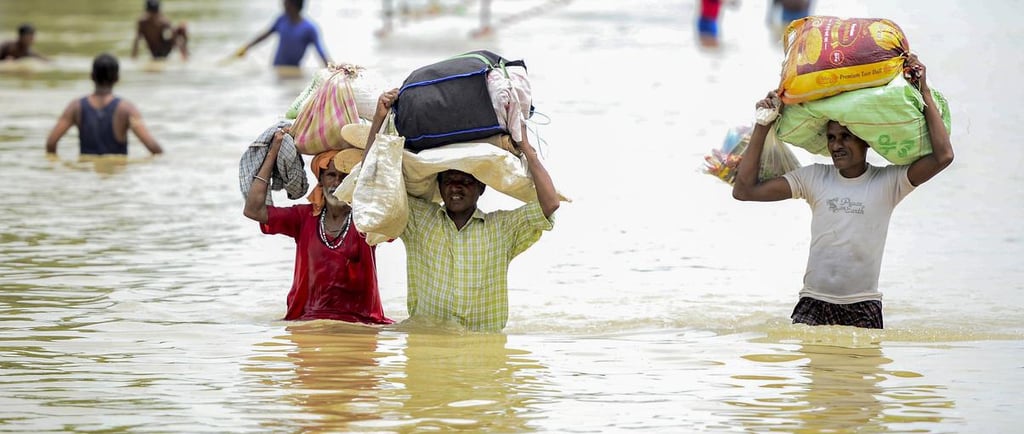India on the Brink: 85% of Districts Now Exposed to Extreme Climate Disasters


Tackling Climate Change in India: Progress and Gaps
India is grappling with a climate crisis that is intensifying at an alarming rate. A recent study by IPE Global and ESRI India reveals that over 85% of Indian districts are now vulnerable to extreme climate events such as cyclones, floods, droughts, and heatwaves. What is even more concerning is that 45% of these districts are experiencing a shift in weather patterns, with previously flood-prone areas now becoming drought-affected, and vice versa. This trend, coupled with a fourfold increase in extreme weather events over the past decades and a fivefold surge in the last ten years, underscores the urgent need for stronger climate action.
The study, presented at the Climate Technology Summit, highlights how climate change is no longer a distant threat but an immediate reality. For example, landslides triggered by erratic rainfall in Kerala, floods in Gujarat, and the rapid disappearance of snow cover on Om Parvat illustrate the growing unpredictability and severity of climate disasters in India. Despite the Indian government’s ongoing efforts to address climate risks, the increasing frequency of these events reveals significant gaps in our current policies.
Government Efforts:
The National Action Plan on Climate Change (NAPCC)
India launched the National Action Plan on Climate Change (NAPCC) in 2008 as a comprehensive framework to address climate risks and promote sustainable development. The NAPCC comprises eight national missions that target both mitigation and adaptation:
National Solar Mission – Promotes solar energy to reduce fossil fuel dependency.
National Mission for Enhanced Energy Efficiency – Focuses on improving energy efficiency across various sectors.
National Water Mission – Seeks to manage water resources sustainably in light of changing rainfall patterns.
National Mission for a Green India – Aims to increase forest cover and enhance ecosystems.
National Mission for Sustainable Agriculture – Supports farmers in adapting to climate impacts on agriculture.
National Mission on Sustainable Habitat – Tackles waste management, urban planning, and public transport to reduce emissions.
National Mission for Sustaining the Himalayan Ecosystem – Works to protect the fragile Himalayan region.
National Mission on Strategic Knowledge for Climate Change – Promotes research and knowledge sharing to enhance climate resilience.
These missions reflect the government’s recognition of the climate challenge, focusing on clean energy, improved efficiency, and building climate resilience across sectors.
Achievements and Progress
India has made notable strides in some areas. The National Solar Mission has been a standout success, positioning India as one of the world’s top solar energy producers. As of July 2024, India has installed over 87 GW of solar capacity, moving steadily toward its target of 500 GW by 2030.
The National Mission for Enhanced Energy Efficiency has successfully helped industries cut their energy use, contributing to a reduction in emissions. The PM-KUSUM scheme, launched to promote solar pumps for irrigation, has also made progress in reducing reliance on diesel in the agriculture sector, lowering emissions.
India’s Green India Mission has spearheaded reforestation projects, with the goal of increasing forest cover and restoring degraded lands, which serve as critical carbon sinks.
Alarming Climate Trends: Rising Vulnerability
Despite these efforts, the IPE Global report paints a grim picture of India’s vulnerability. Over 60% of districts in states like Bihar, Andhra Pradesh, Gujarat, Rajasthan, Maharashtra, and Assam are already experiencing multiple climate events. The frequency of floods has increased fourfold, particularly in eastern, northeastern, and southern India. At the same time, drought occurrences have doubled, especially in agricultural areas, while cyclone occurrences have also risen fourfold.
One of the most significant findings is the “swapping trend” in 45% of districts—where regions once prone to floods are now drought-stricken, and vice versa. For instance, districts such as Srikakulam, Guntur, and Kurnool in Andhra Pradesh have shifted from flood-prone to drought-prone, while areas like Rajkot, Ajmer, and Aurangabad have faced both floods and droughts in recent years. These dramatic shifts are driven by local climate change factors such as deforestation and the destruction of wetlands. Moreover, climate hotspots have seen a 65% change in land use, further exacerbating the risks.
Economic and Social Impact
The rising frequency of extreme weather events is not only a humanitarian crisis but also an economic one. According to the report, India experienced an 8% GDP loss in 2022 alone due to climate impacts, alongside a 7.5% decrease in cumulative capital wealth. These numbers are stark reminders of the economic toll climate change is taking on the nation.
Nine out of ten Indians are already exposed to climate disasters, and the situation is expected to worsen. By 2036, over 1.47 billion Indians could be at severe risk from climate events. This level of exposure requires a rapid scale-up in both adaptation and mitigation efforts.
Gaps and Challenges
While India has been proactive in formulating policies like the NAPCC, several gaps remain that hinder effective climate action:
Lack of Localized Risk Assessments
The growing unpredictability of climate events demands hyper-local climate-risk observatories and detailed risk assessments tailored to specific regions. Many vulnerable districts do not have adequate infrastructure to forecast or mitigate such risks, leaving communities unprepared.Insufficient Implementation of Existing Policies
Although the NAPCC provides a solid framework, implementation at the state and local levels has been uneven. The National Mission for Sustainable Agriculture, for example, has struggled to reach the most vulnerable small-scale farmers who bear the brunt of climate impacts. Similarly, the National Water Mission has yet to adequately address the growing water scarcity exacerbated by shifting rainfall patterns and excessive groundwater extraction.Underfunding of Climate Resilience
India’s investments in climate adaptation remain underfunded. While efforts like the PM-KUSUM scheme have shown promise, scaling up requires significant financial resources, technological innovation, and better coordination between government, private sector, and civil society.Focus on Mitigation vs. Adaptation
Though India’s global CO2 emissions per capita are just one-third of the world average, its total emissions are among the highest globally. The emphasis on mitigation, while necessary, must be balanced with greater attention to adaptation, especially as extreme weather events accelerate. The National Mission for Sustainable Habitat, for example, should prioritize resilience in urban infrastructure to withstand floods, heatwaves, and other climate shocks.
The Path Forward: Building Climate Resilience
To effectively tackle the growing climate risks, India must focus on three key areas:
Hyper-Local Planning and Risk Mitigation
The government should invest in hyper-local climate observatories that can provide early warnings and tailor interventions for vulnerable districts. This is critical in addressing the diverse impacts of climate change across India’s regions.Improved Policy Implementation
Strengthening the implementation of the NAPCC at state and district levels, with greater financial support and stronger governance mechanisms, is essential. Regular monitoring of the missions, especially in agriculture and water management, can ensure that the benefits reach the most affected communities.
Conclusion
India has made important strides in addressing climate change through policies like the NAPCC, but the rising frequency and intensity of extreme weather events make it clear that more must be done. The country is at a tipping point—without stronger, more localized adaptation strategies, and greater investment in climate resilience, the risks will continue to outpace our ability to respond. Building a climate-resilient India requires collective action across all sectors, from government and private enterprise to communities and civil society. The time to act is now
